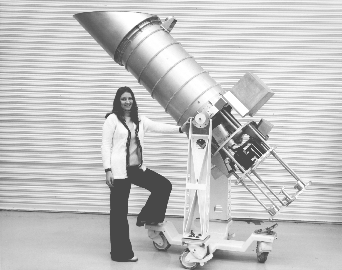 "Bellbottoms didn't last... IUE did." - I.
Tillotson, IUE operations director. (Photo ID: NASA G-74-03178) - 288kb
"Bellbottoms didn't last... IUE did." - I.
Tillotson, IUE operations director. (Photo ID: NASA G-74-03178) - 288kb
The following photos display IUE during various phases of its contruction throughout the mid-1970s. There was minimal information describing many of them. These photos and the associated information were gathered by the IUE Project.
 "Bellbottoms didn't last... IUE did." - I.
Tillotson, IUE operations director. (Photo ID: NASA G-74-03178) - 288kb
"Bellbottoms didn't last... IUE did." - I.
Tillotson, IUE operations director. (Photo ID: NASA G-74-03178) - 288kb
This image shows the core of the science hardware. The telescope tube and
sunshade extend above the pivot point of the support stand, the cameras
are just below, and some of the mirrors and diffraction gratings are at
the bottom. The box extending from the midpoint of the assembly covers
the location of the spacecraft gyros. The small structure near the top of
the tube, just below the angled sunshade, is likely one of the S-band
downlink antennae. This was subsequently removed and installed on another
part of the spacecraft when it was realized that this location would
interfere with the shroud covering IUE during launch.
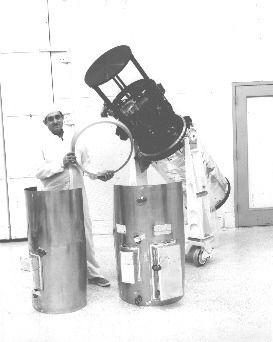 NASA G-75-05659 - 189kb
NASA G-75-05659 - 189kb
A technician displays the shroud and support rings used to cover the
spectrograph assembly, this time raised above the telescope tube. The tube
has been partially covered with mylar thermal insulation, and the
sunshade has been removed.
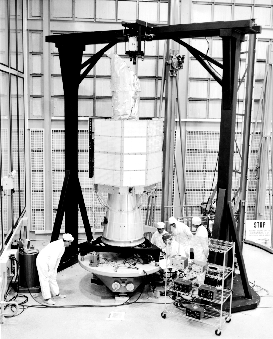 NASA G-75-02466 - 354kb
NASA G-75-02466 - 354kb
Technicians are working on the lower portion of the spacecraft structure;
the solar panels have been folded into their launch configuration. At this
time, the hydrazine propellant system has not been installed.
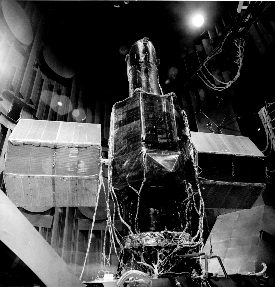 NASA G-75-07221 - 258kb
NASA G-75-07221 - 258kb
IUE has been placed into a testing chamber, perhaps for thermal tests.
The aluminized mylar on the spacecraft has been temporarily covered by
some dark material.
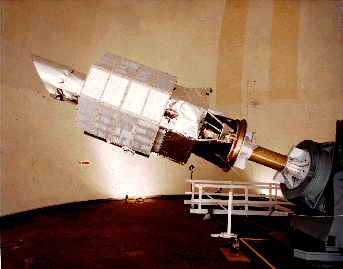 NASA G-77-00915 - 178kb
NASA G-77-00915 - 178kb
The nearly-completed spacecraft is seen undergoing more testing, with the
solar panels folded. The propellant system and engines have been
installed by this time.
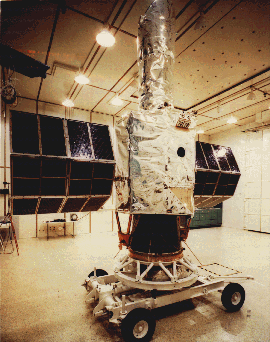 IUE in Goddard Clean Room - 216kb
IUE in Goddard Clean Room - 216kb
IUE is shown fully assembled in a clean room at Goddard Space Flight
Center, prior to shipment to Cape Canaveral for launch.
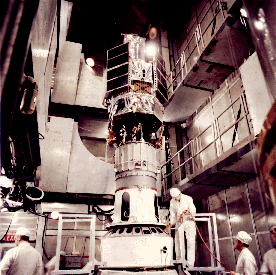 102-KSC-378C-73/4 - 190kb
102-KSC-378C-73/4 - 190kb
IUE is mated to its launch vehicle, a Delta 2914, at Launch Complex 17A,
Cape Canaveral, Florida, and is undergoing final pre-launch checkout. The
solar panels have been folded for the last time prior to launch.
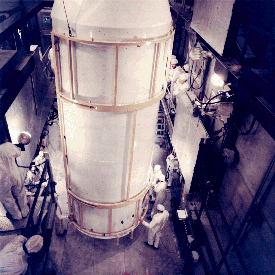 102-KSC-378C-74/5 - 187kb
102-KSC-378C-74/5 - 187kb
Ground technicians are installing the payload shroud atop the launcher
which will protect IUE during its passage through the atmosphere. This
shroud was jettisoned during the ascent phase when the vehicle had cleared
the bulk of the atmosphere.
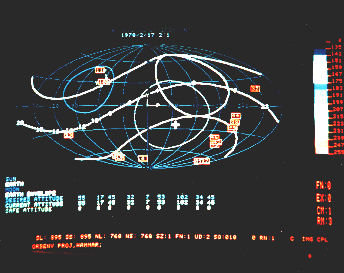 Orbital Environment Display - 53kb
Orbital Environment Display - 53kb
This photo was taken from one of IUE's observer control consoles,
displaying the location of the Earth, Sun, Moon, guest observer targets,
and pointing location of IUE as of around 2:00 UT, 17 February 1978 - a
few weeks after launch. The blue grid encompasses the entire sky. The
numbered S-curve plots the apparent path of Earth as seen by IUE, with the
numbers labeling the UT time that the center of Earth was at that
position. The two curves running parallel to it delimit the Earth
avoidance zone, the region where Earth would either "run over" a
target or produce enough scattered light to hinder observations; the
distorted circle is centered on Earth. (Earth's apparent size is only
about a quarter as large as the avoidance zone.) The Solar avoidance zone
is the circle just right and below center; IUE was never allowed to point
closer than 45 degrees toward the Sun. (The cross near its center does
not indicate the Sun's position; it could be pointed anywhere in the
display.) The Lunar avoidance zone is the circle at left. The numbered
squares are the positions of the Guest Observer's targets. At this time,
IUE was at or near target #101, just inside the Lunar avoidance zone.
| Obtained from IUE project at Goddard Space Flight Center |
14 August 1998 Maintained by MAST Staff |